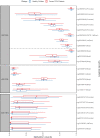Abnormal DNA methylation within genes of the steroidogenesis pathway two years after paediatric critical illness and association with stunted growth in height further in time
- PMID: 37468957
- PMCID: PMC10354984
- DOI: 10.1186/s13148-023-01530-9
Abnormal DNA methylation within genes of the steroidogenesis pathway two years after paediatric critical illness and association with stunted growth in height further in time
Abstract
Background: Former critically ill children show an epigenetic age deceleration 2 years after paediatric intensive care unit (PICU) admission as compared with normally developing healthy children, with stunted growth in height 2 years further in time as physical correlate. This was particularly pronounced in children who were 6 years or older at the time of critical illness. As this age roughly corresponds to the onset of adrenarche and further pubertal development, a relation with altered activation of endocrine pathways is plausible. We hypothesised that children who have been admitted to the PICU, sex- and age-dependently show long-term abnormal DNA methylation within genes involved in steroid hormone synthesis or steroid sulphation/desulphation, possibly aggravated by in-PICU glucocorticoid treatment, which may contribute to stunted growth in height further in time after critical illness.
Results: In this preplanned secondary analysis of the multicentre PEPaNIC-RCT and its follow-up, we compared the methylation status of genes involved in the biosynthesis of steroid hormones (aldosterone, cortisol and sex hormones) and steroid sulphation/desulphation in buccal mucosa DNA (Infinium HumanMethylation EPIC BeadChip) from former PICU patients at 2-year follow-up (n = 818) and healthy children with comparable sex and age (n = 392). Adjusting for technical variation and baseline risk factors and corrected for multiple testing (false discovery rate < 0.05), former PICU patients showed abnormal DNA methylation of 23 CpG sites (within CYP11A1, POR, CYB5A, HSD17B1, HSD17B2, HSD17B3, HSD17B6, HSD17B10, HSD17B12, CYP19A1, CYP21A2, and CYP11B2) and 4 DNA regions (within HSD17B2, HSD17B8, and HSD17B10) that were mostly hypomethylated. These abnormalities were partially sex- (1 CpG site) or age-dependent (7 CpG sites) and affected by glucocorticoid treatment (3 CpG sites). Finally, multivariable linear models identified robust associations of abnormal methylation of steroidogenic genes with shorter height further in time, at 4-year follow-up.
Conclusions: Children who have been critically ill show abnormal methylation within steroidogenic genes 2 years after PICU admission, which explained part of the stunted growth in height at 4-year follow-up. The abnormalities in DNA methylation may point to a long-term disturbance in the balance between active sex steroids and mineralocorticoids/glucocorticoids after paediatric critical illness, which requires further investigation.
Keywords: Aldosterone; Children; Cortisol; Critical illness; DNA methylation; Growth; Height; Paediatrics; Sex steroids; Steroidogenesis.
© 2023. The Author(s).
Conflict of interest statement
We declare no competing interest.
Figures






Similar articles
-
Abnormal DNA methylation within HPA-axis genes years after paediatric critical illness.Clin Epigenetics. 2024 Feb 23;16(1):31. doi: 10.1186/s13148-024-01640-y. Clin Epigenetics. 2024. PMID: 38395991 Free PMC article.
-
Assessment of aberrant DNA methylation two years after paediatric critical illness: a pre-planned secondary analysis of the international PEPaNIC trial.Epigenetics. 2023 Dec;18(1):2146966. doi: 10.1080/15592294.2022.2146966. Epub 2022 Nov 16. Epigenetics. 2023. PMID: 36384393 Free PMC article. Clinical Trial.
-
Long-term impact of paediatric critical illness on the difference between epigenetic and chronological age in relation to physical growth.Clin Epigenetics. 2023 Jan 14;15(1):8. doi: 10.1186/s13148-023-01424-w. Clin Epigenetics. 2023. PMID: 36639798 Free PMC article.
-
Stress hormones and posttraumatic stress symptoms following paediatric critical illness: an exploratory study.Eur Child Adolesc Psychiatry. 2017 May;26(5):511-519. doi: 10.1007/s00787-016-0933-3. Epub 2016 Dec 19. Eur Child Adolesc Psychiatry. 2017. PMID: 27995329 Free PMC article. Review.
-
Glucocorticoid replacement regimens for treating congenital adrenal hyperplasia.Cochrane Database Syst Rev. 2020 Mar 19;3(3):CD012517. doi: 10.1002/14651858.CD012517.pub2. Cochrane Database Syst Rev. 2020. PMID: 32190901 Free PMC article.
Cited by
-
GraphAge: Unleashing the power of graph neural network to decode epigenetic aging.PNAS Nexus. 2025 Jun 3;4(6):pgaf177. doi: 10.1093/pnasnexus/pgaf177. eCollection 2025 Jun. PNAS Nexus. 2025. PMID: 40583914 Free PMC article.
-
The flux of energy in critical illness and the obesity paradox.Physiol Rev. 2025 Jul 1;105(3):1487-1552. doi: 10.1152/physrev.00029.2024. Epub 2025 Feb 21. Physiol Rev. 2025. PMID: 39982115 Free PMC article. Review.
-
On how to feed critically ill children in intensive care: A slowly shifting paradigm.Clin Nutr. 2025 Mar;46:169-180. doi: 10.1016/j.clnu.2025.02.003. Epub 2025 Feb 6. Clin Nutr. 2025. PMID: 39947042 Free PMC article. Review.
References
-
- Mesotten D, Gielen M, Sterken C, Claessens K, Hermans G, Vlasselaers D, Lemiere J, Lagae L, Gewillig M, Eyskens B, Vanhorebee I, Wouters PJ, Van den Berghe G. Neurocognitive development of children 4 years after critical illness and treatment with tight glucose control: a randomized controlled trial. JAMA. 2012;308:1641–50. doi: 10.1001/jama.2012.12424. - DOI - PubMed
-
- Madderom MJ, Reuser JJ, Utens EM, van Rosmalen J, Raets M, Govaert P, Steiner K, Gischler SJ, Tibboel D, van Heijst AFJ, Ijsselstijn H. Neurodevelopmental, educational and behavioral outcome at 8 years after neonatal ECMO: a nationwide multicenter study. Intensive Care Med. 2013;39:1584–1593. doi: 10.1007/s00134-013-2973-1. - DOI - PubMed
Publication types
MeSH terms
Substances
LinkOut - more resources
Full Text Sources
Medical
Research Materials
Miscellaneous

